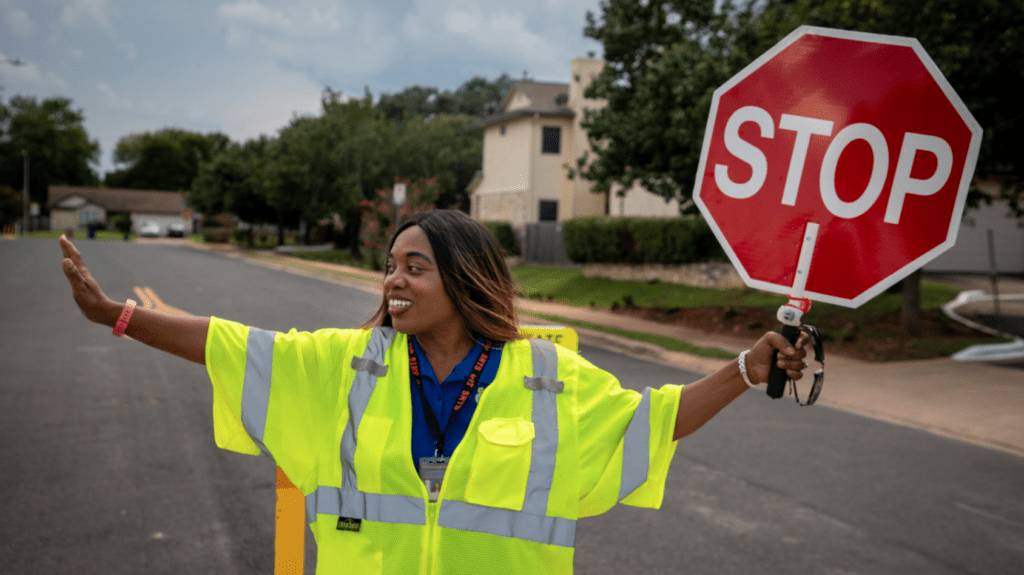UAMS Researchers Address Need in Forrest City for Safer Roads to Promote Physical Activity
| FAYETTEVILLE – A community need for safer roads to increase physical activity among Forrest City children was addressed through a traffic-calming event coordinated by researchers at the University of Arkansas Medical Sciences (UAMS) Office of Community Health & Research, in collaboration with the University of Arkansas System Division of Agriculture Cooperative Extension Service.
Through their study, “Results of a Rural Traffic Calming Event to Promote Physical Activity,” UAMS researchers documented the traffic calming pop-up event, which introduced temporary changes to a traffic route that connected a neighborhood, two schools and a park. Researchers and city administration used traffic cones, signs and pavement marking tape to slow traffic and to promote physical activity, such as walking and biking to school.
According to the Arkansas Department of Health, about 40% of adults and 26% of children in St. Francis County struggle with obesity, compared to the state averages of about 36 and 22 percent, respectively. Arkansas ranks seventh in the country for childhood obesity, according to the State of Childhood Obesity.
The study was conducted as a part of the University of Arkansas System Division of Agriculture’s Arkansas Delta Region Obesity Project (ArDROP), which focuses on promoting physical activity in the Delta. ArDROP is a part of the CDC’s High Obesity Program, which addresses health issues in counties with an adult obesity rate over 40%.
According to the study, 85% of people agreed that the changes made during the event made the area safer for children to walk or bike to school. About 33% of participants agreed that making the changes permanent would increase the likelihood of allowing their children to walk or bike to school to increase physical activity.
“Traffic-calming pop-up events, like the one we conducted in Forrest City, show that there are small-scale solutions to improve walkability and encourage physical activity for both children and adults in Arkansas,” said Marissa Spear, an Office of Community Health & Research evaluator and a lead researcher on the study. “We are grateful to ArDROP and the community leaders in Forrest City for their collaboration on this work.”
UAMS is the state’s only health sciences university, with colleges of Medicine, Nursing, Pharmacy, Health Professions and Public Health; a graduate school; a hospital; a main campus in Little Rock; a Northwest Arkansas regional campus in Fayetteville; a statewide network of regional campuses; and seven institutes: the Winthrop P. Rockefeller Cancer Institute, Jackson T. Stephens Spine & Neurosciences Institute, Harvey & Bernice Jones Eye Institute, Psychiatric Research Institute, Donald W. Reynolds Institute on Aging, Translational Research Institute and Institute for Digital Health & Innovation. UAMS includes UAMS Health, a statewide health system that encompasses all of UAMS’ clinical enterprise. UAMS is the only adult Level 1 trauma center in the state. UAMS has 3,047 students, 873 medical residents and fellows, and six dental residents. It is the state’s largest public employer with more than 11,000 employees, including 1,200 physicians who provide care to patients at UAMS, its regional campuses, Arkansas Children’s, the VA Medical Center and Baptist Health. Visit www.uams.edu or www.uamshealth.com. Find us on Facebook, Twitter, YouTube or Instagram.
The UAMS Northwest Regional Campus includes 288 medical, pharmacy, nursing and health professions students, 64 medical and pharmacy residents, two sports medicine fellows, and 1,000 community-based faculty. The campus has nine clinics including a student-led clinic and physical, occupational and speech therapy. Faculty conduct research to reduce health disparities. Visit www.uams.edu or www.uamshealth.com. Find us on Facebook, Twitter, YouTube or Instagram.
